A.J.S. Rayl • Apr 11, 2018
The Mars Exploration Rovers Update: Opportunity Presses On in Perseverance, Pace Picks Up
Sols 5013 - 5042
In the west rim of Endeavour Crater, Opportunity continued her exploration of Perseverance Valley in March – humankind’s first study of a carved channel in an ancient crater on the Red Planet – while scientists on Earth presented their latest findings from the robot’s returns at a prominent science conference and Mars Exploration Rovers (MER) officials worked on the plan to keep the mission trekking through 2019.
The robot field geologist spent most of the month checking out a couple of new outcrop targets at the “nose” or “upstream” end of an elongated “island” that separates two pathways in the Perseverance Valley’s anastomosing - or branching - structure. Opportunity even scraped into one of the targets with her Rock Abrasion Tool (RAT), her first grind into a rock in 321 sols or Martian days.
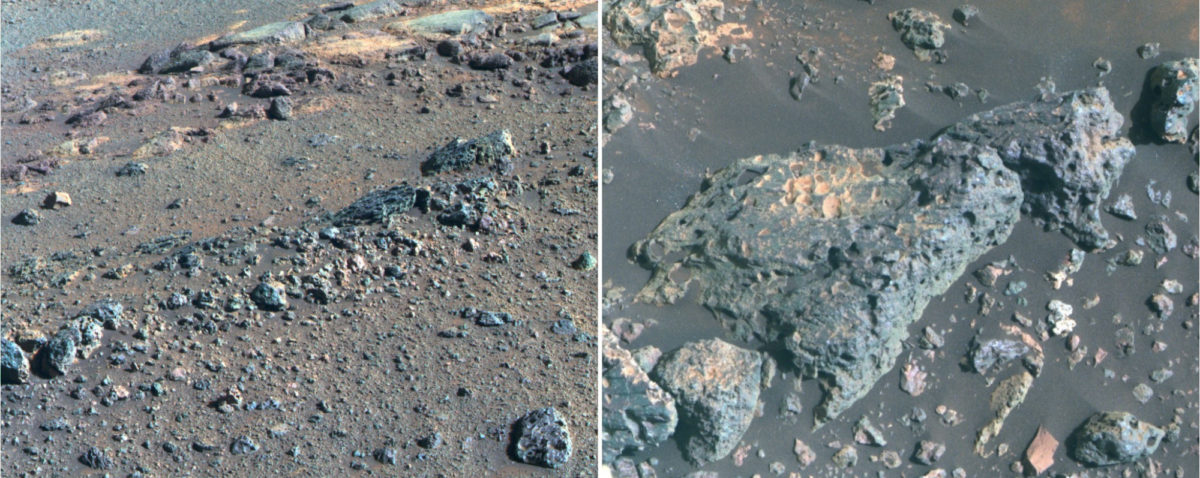
From there, Opportunity navigated a little farther into the valley to some rocks the likes of which this rover has never seen. Despite the aches of pains that have come from driving and exploring Meridiani Planum for more than 14 years, the veteran Mars pioneer continued to show the right robot stuff on the mission’s current quest to determine whether it was water or wind or an avalanche or something else that carved this unique feature into Endeavour’s rim billions of years ago.
With the Martian spring beginning to take hold and the Mars Reconnaissance Orbiter (MRO) out of safe mode and back to helping Odyssey get Opportunity’s data downlinked to Earth, the pace picked up in March. “We’re doing good,” said MER Project Scientist Matt Golombek, of the Jet Propulsion Laboratory (JPL), the NASA center that is mission control for Red Planet rovers and the place where Opportunity and her twin Spirit were designed and built. “And we’re still testing multiple hypotheses to determine the origin of this valley.”
Even though their findings have not yet led to a slam-dunk cause for the formation of Perseverance, the scientists and the rover are making progress and going into some new directions. Currently halfway down the length of the valley, Opportunity has been using both her Navigation Camera (Navcam) and Panoramic Camera (Pancam) at each stop on this journey to visually document the site and the valley’s morphology or form.
When this journey is done, all the site documentation images will be used to create a digital elevation model (DEM) of Perseverance that will give the scientists a real, in-depth look at the unique geological formation. For now, it is through these images and other data the robot sends home that the scientists are uncovering clues and projecting possibilities of what happened here billions of years ago.
In addition to shooting her surroundings, Opportunity added images of selected rocks and soils to her Perseverance science portfolio in March, mostly what was nearby or what caught the eyes of the scientists. On some of those targets, she used her Pancam to take multi-spectral images to determine their mineralogy. Amidst those assignments, the rover kept a daily check on the dust in the sky and took care of engineering tasks necessary to keep roving. It was pretty much seamless.
The weather at Endeavour was about as good as it gets this time of the Martian year. The warmer temperatures of spring enabled Opportunity to work longer hours. But the spring equinox in the southern hemisphere of Mars won’t occur until May 22ndand the notorious Martian winds have not yet begun to whip up dust into devastating storms that can darken the sky, and even kill a solar powered robot. So, March 2018 proved to be a sort of sweet spot of spring, a calm before the seasonal storms.

“Right now is prime time for everything we want to do,” said MER Chief of Engineering, Bill Nelson, of JPL. “It’s not too hot, not too cold, and the rover has plenty of power, upwards of 650 watt-hours, so it’s really an ideal time to be exploring.”
From the “island,” Opportunity had to make a heading change to get to her next destination in the south fork. With only her rear steering wheels steering these days, it proved to be a bit of a trial on the gravelly downward slopes of Perseverance. “There are clear signs she did not like what we asked of her, because the right front wheel current was quite high that drive,” said JPL Rover Planner Paolo Bellutta, who works with the other rover drivers and the scientists to chart the rover’s drives. “But she was there waiting for us to tell her what to do next.”
That heading change put Opportunity on track to her next destination, a long linear group of rocks distinguished by holes, vesicular rocks as the geologists call them, located in the southern margin of the south fork. The scientists had had this site, named San Juan Pueblo, in their sights for a while now. It may be harboring the first volcanic rocks that this rover has ever encountered.
By the end of March, Opportunity was at the vesicular rocks site, which, actually, defines the southern border of the south trough, and had just begun her investigation at San Juan Pueblo. And the plot driving the Story of Perseverance thickened.
“There are highly unusual textures here,” said Ray Arvidson, MER Deputy Principal Investigator, of Washington University St. Louis (WUSTL). “Are the voids [holes in the rocks] actual vesicles that are due to volcanic degassing from an igneous rock?” he asked. “Are they impact melt rocks that have degassed leaving voids or vesicles? And why are they aligned at the trough border?” he wondered.
Those are a few of the unexpected questions the science team members expect to answer with Opportunity’s current campaign centered on these holey targets. Fourteen years and two months after landing for a 90-sol mission, this rover is not only still roving and establishing new records, but is charting new territory and is still forever roving into another Martian mystery.
“We think of Opportunity as the fun rover and it shows,” said MER Project Manager John Callas, of JPL.
Among so many other firsts, Opportunity is the first robot in the solar system it appears to explore the rim segments of a large, ancient crater. “We don’t have a crater that has preserved a rim of this scale on the Earth,” MER Athena science team member Larry Crumpler, of the University of New Mexico and the New Mexico Museum of Natural History and Science pointed out earlier in March.
On completing another highly industrious month that one might describe as Martian Style March Madness, the rover and the mission banked their progress on this first-ever journey and rolled on into April, determined as ever to get to the bottom of Perseverance and the mystery of how it formed. Whatever discoveries are made, whatever the scientific lessons are learned here, they will be important to understanding Mars, and perhaps, to some degree, Earth.
“Things are great, things are busy, and we’re moving on,” summed up Callas.
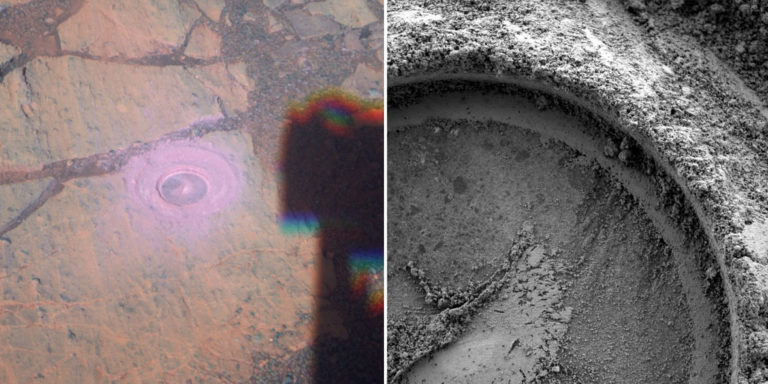
Back on Earth, Opportunity shined – in absentia of course – for the 15th year in a row at the 49th annual Lunar & Planetary Science Conference (LPSC), held March 19th-23rd in The Woodlands, Texas, and for good reason. Under the banner of Depositional and Environmental History, six scientists took to the podium on Thursday afternoon, March 22nd to present the latest in discoveries, analysis, and progress made about Perseverance.
They told of enigmatic clues, obvious hints, fractures and faults, a lake that might have spilled, scoured, eroded outcrops, and of winds that still blow up from the crater floor today, all of which subtly informed that we still have much to learn about Mars – and this one-of-a-kind valley. “It’s a work in progress,” said MER Principal Investigator Steve Squyres, of Cornell.
Actually, Opportunity still has half the valley to go and the MER scientists mostly agree that they need the rover to get to the bottom of Perseverance before they can effectively determine what exactly carved this feature into the crater. The primary working hypotheses – water, wind, and debris flow – remain in the running.
Still, there was a sense at LPSC that the science team seems to be closing in on figuring out how Perseverance came to be. There are a number of issues to resolve and what the rover and her human colleagues have been finding implies a complexity that may take a while to completely unravel. Time and more research will tell. More complete coverage of the MER LPSC presentations, the directions the research is taking the rover and theories being shaped by Opportunity’s recent finds, is to be posted soon in a separate MER Update Special Report.
For the time being, the scientists exploring Perseverance with this willing, ever-capable robot are living a mystery novella that as of yet has no slam-dunk ending, not yet. This off-Earth adventure, imagination-sparking distraction, reality computer-monitor series, by whatever description,is Mars exploration in real time and any Earthling with a computer and access to the Net can hitch a ride.
Departing the LPSC session with Opportunity’s mystery still “a work in progress” brought another Martian mystery to mind for some MERsters, one that was never really solved and likely will not be in our lifetimes. It was on the same day, March 22nd, eight years before, in 2010, that the team, and hence the world, received its final electronic message from Opportunity’s twin.
Stuck in a tiny sand-filled crater, as the mission’s fourth Martian winter set in, Spirit presumably had gone into a hibernation mode as programmed. Team members hoped to hear from the rover by early 2011, once she had a chance to re-charge her solar-powered batteries. But Spirit never phoned home.
More than 1300 commands had been sent to the ‘bot through the Deep Space Network X-band and the ultra-high frequency (UHF) relay communications systems with Odyssey and MRO. It was tough. No one wanted to believe it was the end. After the 14th straight month of silence and not so much as a ‘beep,’ NASA in May 2011, declared the mission of MER-A over, and before the end of June that year, after the last attempts to ping Spirit were sent, it was.
While the scientists corralled themselves in Texas, in California, Callas, in addition to overseeing mission ops, worked on the budget and proposal for NASA that will hopefully keep the team and its ‘bot effectively exploring through 2019. “We are privileged because NASA officials are talking about giving us another year of funding,” said Callas. “But the funding levels are very difficult.”
MER’s previous, approximate $14 million annual budget was cut by more than $1 million for the current mission extension (2017–2018). And the annual budget will be lower still for 2019.
Despite the fact that this rover and MER mission have produced success the likes of which has never before been seen in planetary exploration and that Opportunity is continuing to boldly go where no rover has gone before, still making discoveries and setting new records, the impact of the additional cuts likely will reduce MER’s ops staff. That could result in reduced exploration. Which, in a thoughtful world, would seem to make no logical sense.
However, with a number of newer, faster, more sophisticated robots either en route to the Cape or in development, another reduction in budget is apparently fait accompli. No negotiating room. The budget to support Opportunity will decrease again. If that is, the robot hero pioneer passes her next extension audition.
Callas and Squyres are slated to present the plan for Opportunity’s 11thmission extension to a Senior Review in early May. As the process goes, the Senior Review will make recommendations to NASA officials, who, in turn, will make the final decision. This extension will be for 2019, just one year. That’s because, beginning in 2020, word is, NASA plans to grant mission extensions every three years as opposed to every two years.
Callas projected positively: “We just have to be thankful for the funds that we do get.”
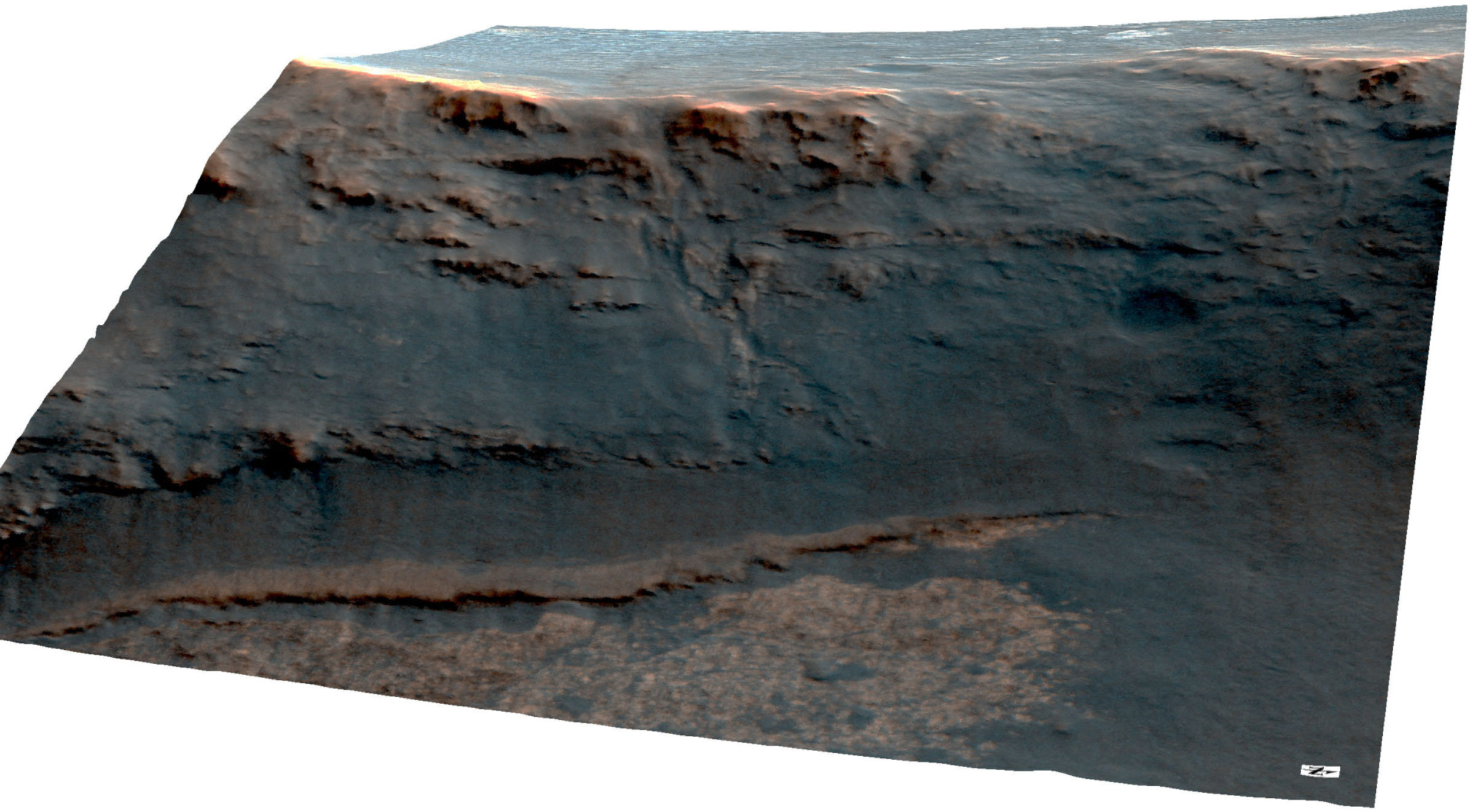
Deep Dive into March
Opportunity woke up to a Martian day striking enough as March dawned on Endeavour Crater. The robot’s power levels were robust. With 45.12 kilometers (28.04 miles) on her odometer, she was producing upwards of 675 watt-hours, with a solar array dust factor of 0.873. The atmospheric opacity or Tau was a slightly hazy 0.507. It was a good day at Endeavour Crater, Mars.
Positioned about halfway down the 200-meter (656-foot) valley, Opportunity eased into the month, spending the first two days of March (Sols 5013 and 5014) taking targeted images of the view, including the streamlined formation the team calls “the island.” Then, on Sol 5015 (March 3, 2018) the ‘bot bumped 4.04 meters (13.25 feet).
The short jaunt put her at the edge of the island, which was christened Ysleta del Sur in March, following the current naming theme of stops along the El Camino Real de Tierra Adentro, the old, 2,560-kilometer (about 1,591-mile) trade route between Mexico City and San Juan Pueblo, New Mexico.
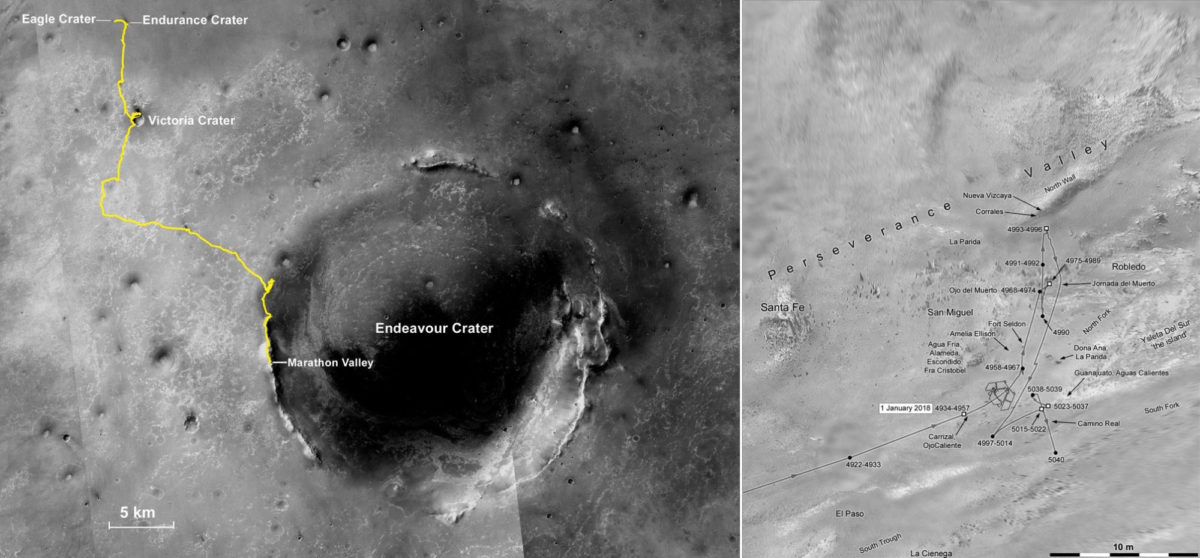
From this spot, Opportunity spent the next two sols (5016–5017, March 4 and 5, 2018) taking Navcam frames for a 360-degree panorama, and more targeted Pancam images of the nose of the island, as well as to the left, looking down the north fork and then looking down the south fork, the two channels that branch from the valley.
On Sol 5018 (March 6, 2018), Opportunity used her Microscopic Imager (MI) to take the pictures needed for a mosaic of a surface target of interest on the outcrop the team named Guanajuato. Once the rover had completed shooting the MI pictures, she followed the routine science protocol and placed her Alpha Particle X-ray Spectrometer (APXS) on the chosen spot for a multi-hour integration to analyze the chemical composition.
As the second week of the month got underway, Opportunity spent sols 5020 and 5021 (March 8 and 9, 2018) continuing the analysis of the chemistry of Guanajuato and taking care of some routine tasks. On Sol 5022 (March 10, 2018), the rover used the APXS to take an argon measurement for the mission-long study.
Opportunity then moved just 0.39 meters (1.27 feet), on Sol 5023 (March 11, 2018) essentially lifting her right rear wheel off the exposed rock outcrop and adjusting to home in a target spot on the same outcrop, a spot the team dubbed Aguas Calientes.There, the robot used her RAT to brush on Sol 5025 (March 13, 2018) the target in preparation to grind the weathering rind off Aguas Calientes. And then the rover took close-up MI pictures for a mosaic.
“We’re right at the very upstream end and we stopped to see if we could see any evidence of fluvial erosion,” said Golombek. “What we see is this incredibly smoothed off surface that has strong evidence for Aeolian abrasion. There are these little wind tails around rocks that are resistant. And at the science team meeting, we learned that the RAT was in pretty good shape and we probably don’t need to be quite as careful about it. There is always value in going beneath the weathering rind and so this was a huge flat rock and it was ideal.”
Opportunity put in a full sol’s work on Sol 5026 (March 14, 2018). She took another MI stereo mosaic of the freshly brushed Aguas Calientes, placed the APXS for a multi-hour integration, and then took a panorama with her Navigation Camera, which she successfully sent home via the orbiter. She used her APXS again that evening and, with that assignment finished, wrapped the second week of March.
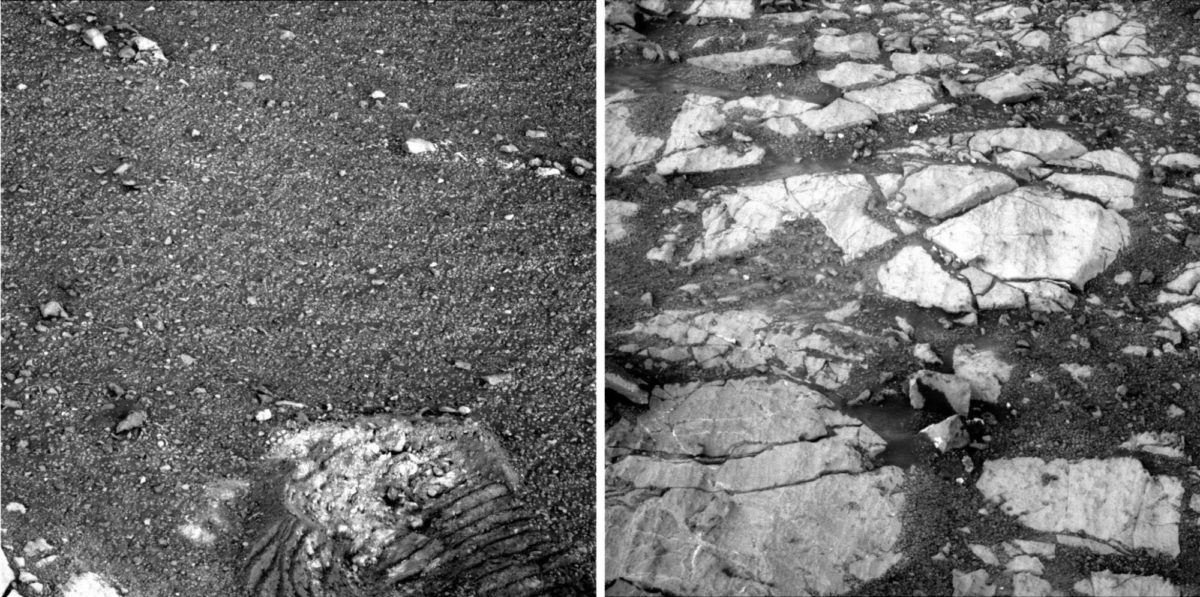
For most of the third week of March, Opportunity extensively investigated Aguas Calientes. After taking the routine Tau with her Pancam on Sol 5027 (March 15, 2018), the rover she used her RAT to grind into the flat rock target, approximately 2 millimeters. It was the first RAT grind Opportunity had done in 321 sols. Again she brushed Aguas Calientes to remove the grind tailings.
“It was a beautiful grind,” said Callas. “The RAT bit seems to be in good shape; [the Honeybee robotics operators] can’t discern any difference in the amount of bit remaining so that’s all good. We think we have between 20–25% of the bit left and that was the same amount we had like 5 years ago. The RAT keeps grinding and grinding.”
Sol 5028 (March 16, 2018) began like so many: Opportunity used her Pancam to take a Tau. Then, this aging veteran turned into the Energizer Rover.
The robot completed a finder frame on Aguas Calientes in preparation for placing the APXS later, and then used her Hazcam to take a RAT bit survey offset in RAT hole. She took more MI pictures for another mosaic of the Aguas Calientes and, as is the usual science routine, placed her APXS for a multi-hour integration. Following the Odyssey pass during which she sent her sol’s data so far to the orbiter, the robot put the APXS down on Aguas Calientes for more analysis of the outcrop’s chemical composition.
Powered up, Opportunity was able to spend the next two sols, 5029-5030 (March 17–18, 2018) doing a little bit of everything. She took images, of course, with both her Pancam and Navcam, shooting the sky and her deck. She conducted another APXS integration and while her APXS was gleaning the chemical composition of the freshly grinded Aguas Calientes, the robot took a high Sun survey and a horizon survey, and some previously missed 13 filter images of selected targets, a stereo color survey, basically a series of images of outcrop and rocks toward the end of the island.

Opportunity spent her Monday on Sol 5031 (March 19, 2018), remote sensing. She had an early MRO pass and late handover, so there was not much time to do a lot, but the rover succeeded in taking a PC Tau and re-shooting some Pancam images. After the MRO pass, the robot re-shot a complete 360 Navcam, took some twilight images with her Pancam; and a post Odyssey pass integration of Aguas Calientes 2.
Although the target had been ground already, the science team wanted to grind Aguas Calientes another 2 millimeters deeper. So, on Sol 5032 (March 20, 2018), the robot deployed her RAT, fired it up and dug in another 2 millimeters, right over the original spot, and the team labeled it Aguas Calientes 3.
During the grind, the Inertial Measurement Unit (IMU) reported a problem. Designed to emulate a human field geologist Opportunity and her twin Spirit were designed with parts that simulate human parts; the rovers’ onboard computers are their “brains;” and their Pancam, high-resolution color stereo pair of CCD [charge coupled devices]located on a "camera bar" that sits on top of the mast of the rover are their “eyes.” The IMU, which essentially estimates the rover's tilt, helps it to maintain balance, and make precise movements, is kind of like our inner ear.
Prior to any challenging drive, particularly if there are steeps slopes or intense turns involved, the ops engineers run what they call a nadir check on the IMU, where the onboard gyros measure accelerations in all three axes to check the rover’s lowest point and its position or ‘stance’ on the terrain. There is of course a difference in acceleration based on Mars gravity and Mars rotation, so those values will change if the rover is not level to the surface.
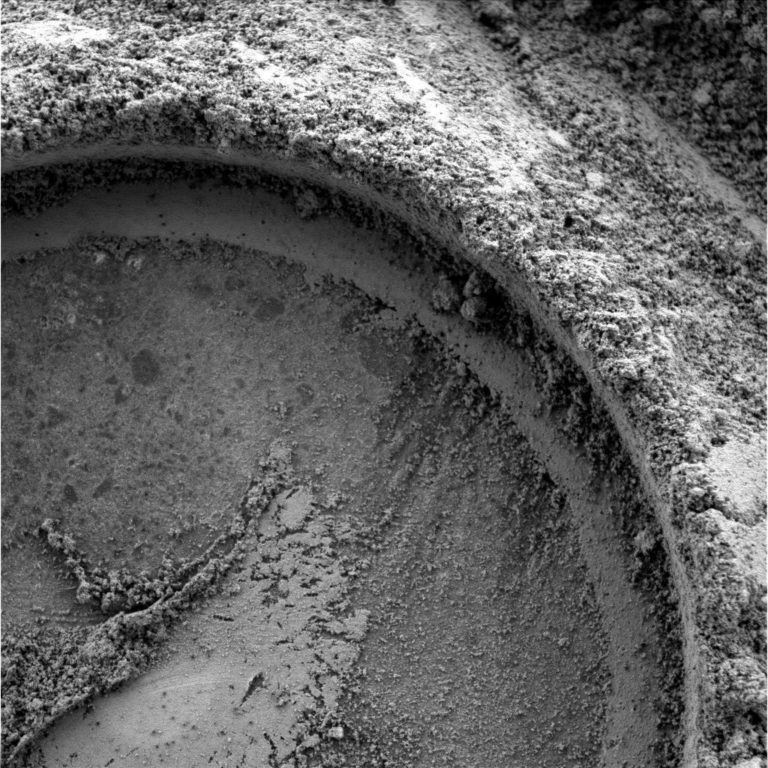
The engineers had turned on the IMU, measured nadir, then instructed Opportunity to do the RAT grind. Everything was fine. But then when they ran a second nadir check to see if rover position altered at all by moving IDD around, the IMU returned a notice that the overall state of IMU was ‘sick,’” said Nelson. “That could indicate there might be something wrong with IMU, something that we have not seen before.”
While the op engineers contemplated the weird IMU flag, Opportunity followed procedures and finished her work. The robot used the instrument’s brush to clear the tailings from the target after the grind, took the MI pics for a mosaic of the freshly grinded rock, and then placed her APXS on the spot for a multi-sol integration. She also collected a set of 13-filter Pancam images of Aguas Calientes, and took two separate Pancam pics of Camino Real, a messy row of rocks that extends over some distance, one looking southwest and close, and the other one looking southwest, more distant.
On Sol 5033 (March 21, 2018), Opportunity took another MI stack on Aguas Calientes 3, looking again at the re-RATed hole, and after another APXS integration on Aguas Calientes, took some Pancam 3 sky thumbs, a horizon survey, and a mosaic of Camino Real.
The engineers also checked out the IMU again. “After re-sequencing the nadir checks, they came back fine, suggesting the problem was a sequencing issue and not a hardware issue,” said Nelson. Still they planned to check it again in coming sols.
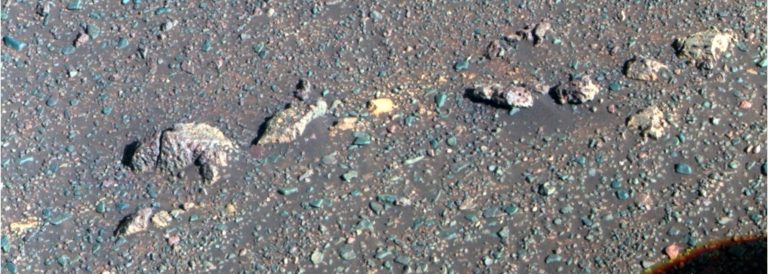
Opportunity shot her way into the fourth week of Mars on Sol 5034 (March 22, 2018), taking a 360 Navcam, and using her Pancam to take a horizon survey, and then a 13-filter image on Aguas Calientes; and a photo survey looking northeast on far side of island.
On Sol 5035 (March 24, 2018), Opportunity moved her IDD to offset the APXS for further analysis on Aguas Calientes 3, then ran a planned IMU test. Again, the IMU was deemed healthy.
“The little hiccup with IMU, the inertial measurement unit, gave us a bit of a scare,” said Nelson. “It turned out the hardware is fine and our rover is in wonderful condition considering 14 years on Mars. That was a big relief.” Still, the engineers will do some more additional testing just to be sure.
On Sol 5035 (March 24, 2018), Opportunity imaged the RAT bit to check for wear. Amazing but true, no additional bit wear was seen after the grind. The ‘bot also captured MI stereo images that were taken with the instrument centered over Aguas Calientes. “We were also attempting to find where we are placing sweet spot of APXS on Aguas Calientes 4,” said Nelson. After the Odyssey pass, the rover placed her APXS on Aguas Calientes 5 for another integration.
The rover engineers conducted some extra nadir checks that showed IMU. It was still fine. Opportunity spent her Sol 5037 (March 26, 2018) really working the cameras. She took some 13-filter Pancams of Aguas Calientes and another science-selected target, as well as Pancam frames of the south fork or trough, and images of some vesicular outcrops, a long strip of rocks in that trough. The robot also used her Hazard Camera to inspect her RAT bit. And post Odyssey again placed her APXS on Aguas Calientes 5 to continue analysis of the rock’s internal chemical composition.
Taking one last shot at Aguas Calientes to try and get an image of the target without shadow Opportunity finished up on the close-up work of this outcrop on Sol 5038 (March 27, 2018). Then, the rover bumped away, carefully moving about 2.6 meters (8.53 feet), to change heading and avoid an encounter with a worrisome large rock nearby.

After a Quick Fine Attitude, Opportunity took some post drive Navcams, a color clast survey, and some twilight imaging to capture soil in front of rover. The next sol, 5039 (March 28, 2018) was a day for remote sensing. After some routine Pancam dust monitoring, the robot took a Pancam horizon survey, another color clast survey, and some twilight images, again to capture the soil in front of the rover.
With that, the rover that loves to rove was ready to move on. First, Sol 5040 (March 29, 2018), Opportunity took another Pancam image of Aguas Calientes, and another of the soil, terrain right in front of her. Then, she fired up her engine and headed south-southeast for the linear string of vesicular rocks.
The rover cruised right over Camino Real. “We drove right over it to get to vesicular rocks,” said Arvidson. Following the brisk 4.46 meter (14.63-foot) drive, she was there. Her odometer held at 45.12 kilometers (28.04 miles). After the usual Odyssey pass, the robot used her APXS to measure the atmospheric argon.
Opportunity woke up the following day, Sol 5041 (March 30, 2018),in yet another new little world. Not surprisingly, the robot spent her day shooting Pancam images of vesicular-ville, which the team promptly named San Juan Pueblo on the mission’s arrival. But the robot’s work was constrained because of poor downlink data volume.
The following sol, 5042 (March 31, 2018), Opportunity did an IDD Salute – moved her arm up and out of the way for imaging – and took some 13-filter Pancams of San Juan Pueblo and then called it a sol, shutting the lights off, finishing another productive month on Mars.
On Earth, the scientists found multiple colors for these rocks from the Pancam multispectral images...why?
As March faded into history, Opportunity didn’t blink and the scientists had new data they couldn’t stop considering. The dutiful robot – which by all reports, is “in great shape” – kept at the up-close investigation of the vesicular rocks as April began, looking to add something to this rocky story of Perseverance Valley, and ready to uncover the answer to the big question at the end of this “road.”
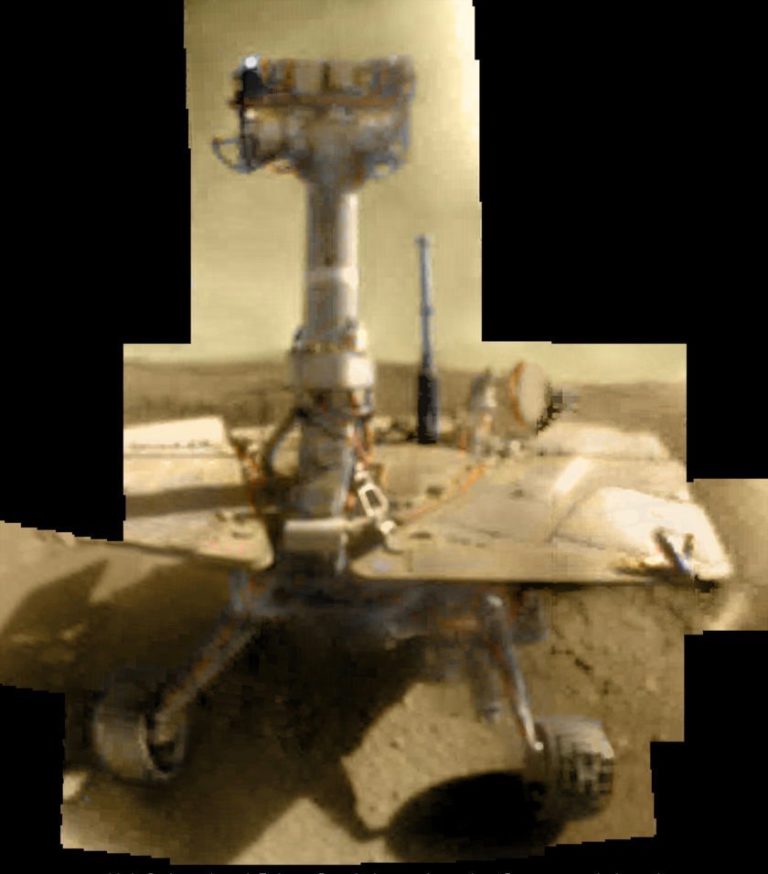
Support our core enterprises
Your support powers our mission to explore worlds, find life, and defend Earth. You make all the difference when you make a gift. Give today!
Donate

 Explore Worlds
Explore Worlds Find Life
Find Life Defend Earth
Defend Earth

